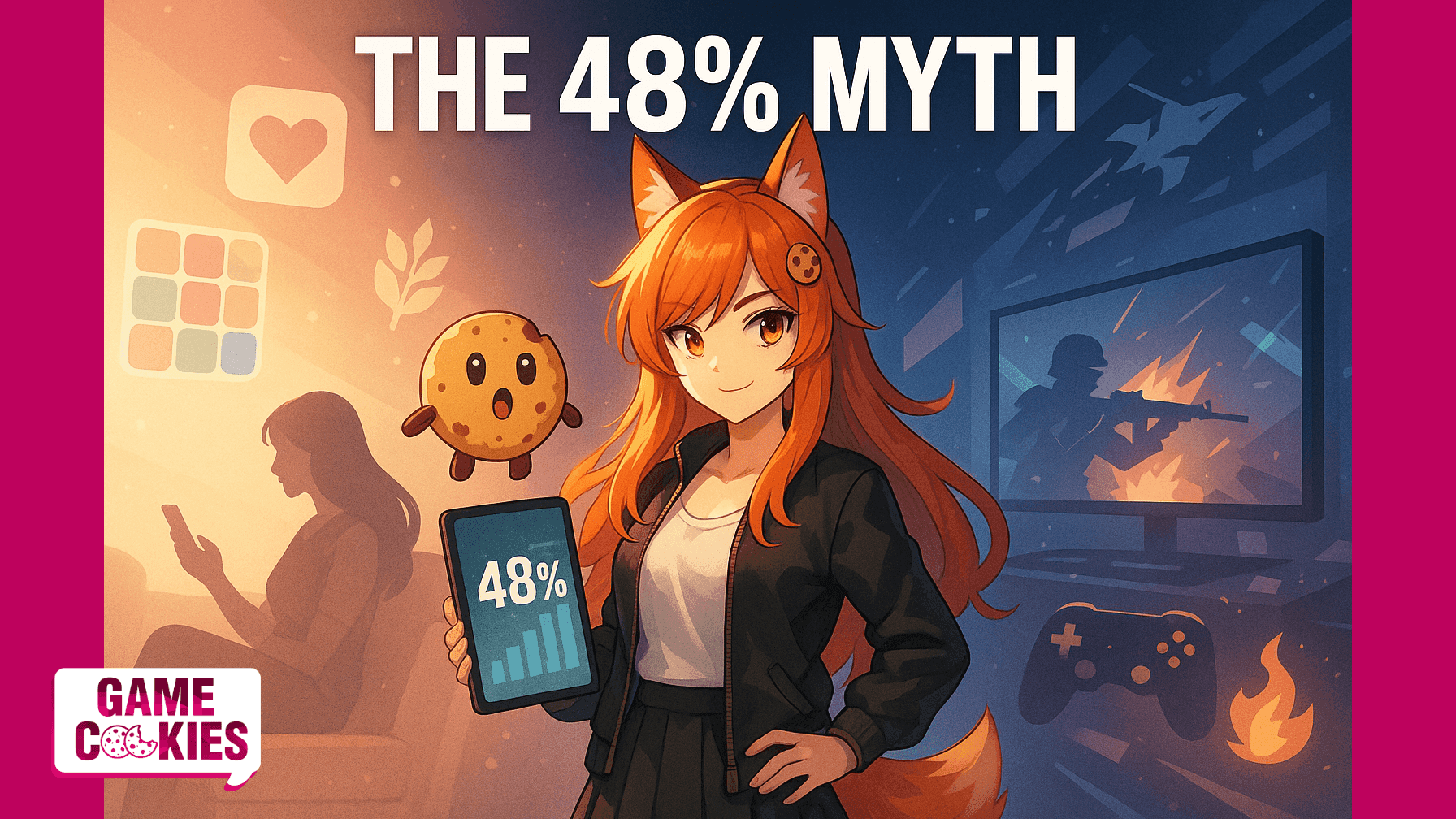
🍪 Analyxyz: The 48% Myth — Why “Half of Gamers Are Women” Isn’t the Whole Story
Hello there, data lovers and industry mythbusters. Today, Game Cookies dives deep into the Entertainment Software Association’s 2025 Power of Play report — the one every outlet is quoting to say “48% of gamers are women.”
Sounds like victory, right? Equality achieved! Time to roll the credits. Except… not really. Because that number doesn’t tell the story you think it does. It’s technically true — but contextually misleading.
Most of those “female gamers” aren’t playing Call of Duty, Helldivers 2, or Baldur’s Gate 3. They’re playing Candy Crush on the bus or Wordle between meetings. So before we celebrate gender parity in gaming, let’s break down what that 48% actually means — and why lumping mobile and AAA players together is like comparing Clash of Clans to Counter-Strike.
📊 The Headline Everyone Ran With
According to the ESA, 48% of U.S. gamers are female — nearly equal to men. Globally, the figure hovers around 45–50%, and in some countries (like Brazil), women even make up the majority of players.
It’s a good headline — but a messy truth. Because the “player base” that drives that statistic isn’t the same one driving console sales, AAA budgets, or esports audiences. In short: yes, women are half of gamers — if you count mobile.
📱 The Mobile Takeover
ESA’s own data says 64% of female gamers play on mobile, compared to less than half of men. In other words, mobile is the female-dominated platform — and it’s the reason that 48% exists at all.
🦊🎙️ Kiki: Yeah, that’s the part nobody mentions. The industry hears “half of gamers are women” and immediately posts stock photos of girls holding controllers — when most of those women are holding phones.
Mobile and hypercasual games — Candy Crush, Gardenscapes, Royal Match — opened the gates for a broader audience. That’s great! But let’s not pretend it’s the same arena as console or PC gaming. The average Call of Duty player isn’t the same as the average merge-three puzzle fan. Different engagement, different expectations, different economics.
🍪 Chip floats in with a smartphone showing Candy Crush, nodding proudly.
🕹️ Meanwhile, in “Core” Gaming…
Now let’s check the PC and console side — where the biggest studios, budgets, and headlines live.
Here, women make up only 22–28% of players, depending on the region. In other words, three-quarters of “core” gamers are still men.
🦊🎙️ Kiki: Exactly. You can’t drop the 48% stat into a Call of Duty boardroom and expect it to hold. That’d be like saying “half the world speaks Spanish” because you included everyone who knows hola from Duolingo.
Core genres — shooters, action, open-world adventures — remain male-dominated. Casual and simulation genres — puzzle games, The Sims, Animal Crossing — lean heavily female. The “gender parity” headline only exists because both groups got shoved into the same spreadsheet.
🍪 Chip flips a stat sheet, revealing two separate charts labeled “Mobile” and “Console.”
🧩 Casual ≠ Core
Globally, 44% of female gamers play exclusively on mobile, while only 27% of male gamers do. That means nearly half of women who play games never touch a console or PC.
🦊🎙️ Kiki: And that’s fine! But we have to stop pretending that makes the industry balanced. If someone spends 10 minutes a day on Wordscapes, that’s not the same behavior as grinding 40 hours a week in Destiny 2.
The gender gap isn’t in who plays — it’s in how deeply they’re involved. Men over-index in “core” games because that’s where the most time, money, and cultural identity sits. Women dominate in casual because mobile lowered the barrier to entry — but that’s also where the least developer representation, visibility, and investment are.
🍪 Chip holds up two cups labeled “Casual Coffee” and “Core Espresso.”
🎮 Genre by Gender
Let’s break down the numbers:
Top genres for women: Casual (39%), Strategy (34%), Simulation (31%)
Top genres for men: Action (48%), Action-Adventure (45%), Shooter (38%)
🦊🎙️ Kiki: Translation: women build farms, men blow them up. We’re not talking biology here — we’re talking culture. Games have been marketed differently for decades. When you design every AAA trailer like a Michael Bay movie, you’re gonna attract Michael Bay fans.
Until marketing, design, and community management evolve, we’re gonna keep seeing that split: women owning mobile and simulation, men crowding shooters and sports.
🍪 Chip wears a tiny construction hat next to a tank.
🎯 Why It Matters
Because this one statistic — “48% of gamers are women” — keeps getting used out of context. Publishers love it because it makes the market look inclusive. Analysts love it because it sells optimism. But it hides a real problem: the audience is segmented, not unified.
🦊🎙️ Kiki: If you work in the industry, read this carefully: gender parity at the aggregate level doesn’t mean your audience is balanced. If your studio makes AAA shooters or RPGs, your market is still majority male. If you’re in mobile casual, your market is majority female.
Pretending it’s 50/50 everywhere helps no one. It just muddies real demographic insight.
🍪 Chip holds up two graphs that clearly don’t add up to 100%.
Stay sharp like Kiki.
Keep skeptical like a data analyst.
And remember: in 2025, “half of gamers are women” — but most of them are playing on a phone while the industry still builds for a controller.
Sources
Entertainment Software Association — Power of Play 2025
ESA — Essential Facts About the U.S. Video Game Industry 2025
Newzoo Global Gamer Study (2024–2025)
Statista Consumer Insights (2024)
Bryter — Women Gamers Report 2024
Newzoo & GameAnalytics data (genre and platform breakdowns)
Have any topic that you want us to go deeper or debunk? Write us here!







